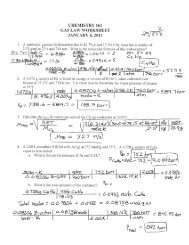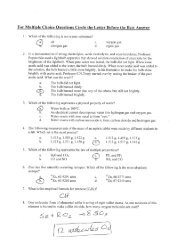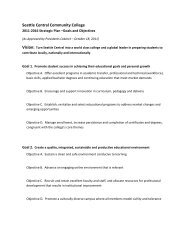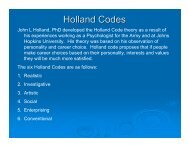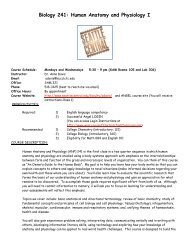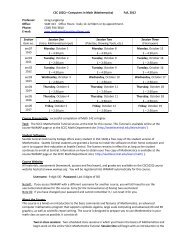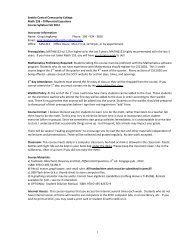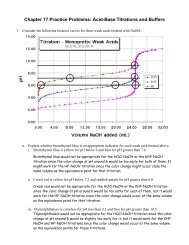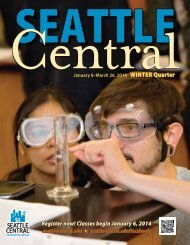Biology 128 - Seattle Central Community College
Biology 128 - Seattle Central Community College
Biology 128 - Seattle Central Community College
You also want an ePaper? Increase the reach of your titles
YUMPU automatically turns print PDFs into web optimized ePapers that Google loves.
HomeostasisBaby Dies From Overdose At Children’s HospitalChildren's Hospital CEO Dr. Tom Hansen said a nurse in the intensive care unit"administered 10 times the intended dose of a medication, calcium chloride." Headded, "The infant was profoundly fragile and succumbed to complications."http://www.komonews.com/news/local/103907864.htmlhttp://www.kirotv.com/news/25191587/detail.htmlhttp://seattletimes.nwsource.com/html/localnews/2013016258_infantdeath29m.html?syndication=rss3
Building an Organism (and theway we approach this course)• Chemical Level: atoms (e.g. carbon, hydrogen and oxygen)combine to form molecules (e.g. glucose C 6 H 12 O 6 )• Cellular level:– Smallest living units in organisms are cells– Cells contain organelles, each with a function (e.g.mitochondria produces energy in the form of ATP)• Tissue level - groups of similar cells that perform a function(e.g. form a barrier like epithelial tissue).– 4 types of tissue: epithelial, connective, muscle, nervous• Organ level – At least two different types of tissues(connective and muscle) that together perform a commonfunction (e.g. heart)• Organ system level – consists of different organs that workclosely together (e.g. cardiovascular system)5
Structure-Function Relationships: Are the different shapes,sizes of the cells important for function??6
Structure-Function RelationshipsWhy is the left side of our heart thicker thanthe right?7
Structure-Function Relationships8
Common Challenges (to Homeostasis)Faced By Living Organisms• Maintain boundaries• Sense and Respond to Environment• Move• Obtain Energy from Food, Oxygen• Remove Waste• Grow• ReproduceEating in a fresh water dwelling, single-celled organism:Paramecium (protozoan)http://videosift.com/video/Paramecium-eatingpigmented-yeast9
Organ Systems Interact to MaintainHomeostasisFrom: Silverthorn HumanPhysiology anIntegrated Approach11
Organ Systems12Figure 1.3a–c
Organ Systems13Figure 1.3d–f
Organ Systems14
Organ Systems15Figure 1.3j–l
What organ systems are used toperform these important functions?• Maintain boundaries• Sense and Respond to Environment• Move• Obtain Energy from Food, Oxygen• Remove Waste• Grow• Reproducehttp://videosift.com/video/Paramecium-eatingpigmented-yeast16
241:IntegumentarySkeletalMuscularCardiovascularLymphaticRespiratoryPlus: Cells andTissues242:NervousEndocrineDigestiveUrinaryReproductive17
ANP 241: Human Anatomy andPhysiology IInstructor: Dr. Anna DavisWebsite: http://www.seattlecentral.edu/faculty/adavis/We also have an Angel shell that we will use for all course materialsat the end of this week.18
IntroductionsPlease write the following on your notecard– Name– Year you graduated high school unless you are stilla student and where– Career goals– List of classes you have taken that may help you inthis class and WHEN you took them (e.g. BIO 101,Autumn ’08)– List of courses you are taking this quarter– List any other relevant experience you’ve had thathelps you understand physiology (job, internship,taking care of relatives, etc.).– Preferred email address 19
Syllabus highlightsClass meets Monday and Wednesday 5:30- 9LECTURE in room 105LAB in room 306FINAL EXAM: Monday 3/21 5:30 – 7:3020
Contact Info• Email: adavis@sccd.ctc.edu and viaANGEL email email is the best way to contact me• Office: SAM 321• Office hours: by appointment21
Course websiteThe website has:– Syllabus– Lecture notes as pdfs– Objectives (learning goals aka studyquestions) for each unit– Resources to help you study– Homework Assignments*All communication will be via Angel forclassroom support starting 1/10.Navigating to ANGEL 22
Required texts (?) …You will use in242Fundamentals of Anatomy & Physiology,8e F. Martini and J. NathISBN: 0-321-50571-9Exploring Anatomy and Physiology in the Laboratory ©2010Author: Erin C. AmermanProduct Code: 7975ISBN-13: 9780895827975Additional resources that come with your textbook:myAandP: http://www.myaandp.com/booksAvail.htmlInteractive Physiology:http://www.physiol.med.uu.nl/interactivephysiology/ipweb/home/index2.html23
GradingAssessment Method Point Value % Points3 Exams 100 pts 40% 4001 Final Exam 200 pts 20% 2005 (Weekly) Quizzes 20 pts 10% 10010 (Weekly) HomeworkAssignments (e.g. studyquestions, discussionboard posts, minipresentations,pre andpost labs)15 pts 15% 1501 Group Project 100 pts 15% 100Participation 50 pts 5% 50TOTAL = 100024
Grade percentages4.0 - 3.5 A / A- 90 - 100%3.4 - 2.9 B+/ B 80 - 89%2.8 - 2.2 B-/ C+ 70 - 79%2.1 - 1.5 C / C- 60 - 691.4 - 0.7 D+/ D 50 - 59%0.0 E below 50%25
How to Succeed• This may be a difficult class for you but there is lotsof support to make it easier and with hard work, youcan succeed.• I am here to help you learn the material so please askquestions regularly both in person and by email. We’llpractice this.• Please expect 7 – 14 hours of reading and studyingeach week in addition to class sessions• Tutoring is available (OPEN LAB – TBA)• The pace is fast so missing class is not recommended• Form study groups this week• I hope you will work hard, learn a lot and have funalong the way.26
4 Exams and 5 Quizzes:Quizzes/Exams– Check Website for Updated Quiz/Exam Schedule. Thesedates are tentative until confirmed.– Combination of objective questions: multiple-choice, matching,true/false and fill-in-the-blank plus short answer, shortessay, and diagram and model labeling.– We will have mini-reviews before each test so that you canassess your exam readiness and study accordinglyStrict Exam Rules: Tests may not be rescheduled or made-up due totardiness or absence. Students with extraordinary circumstancesshould discuss them with the instructor as soon as the situationoccurs.27
Weekly HomeworkYou will have weekly homework assignments that mayinclude answers to lab worksheets, study questions,short analyses of papers we read together, discussionboard posts, etc.Homework will typically be assigned on Mondays and bedue on Sundays via Angel drop box or Mondays at thestart of class.No late work will be accepted.28
Lectures• My powerpoints will be posted on the course websitebefore lecture• Lecture slides may not cover ALL the material you willfind on exams (but the vast majority of my examquestions come from lectures, labs, and my studyquestions that guide your reading).29
Questions?30
Homeostasis (homeo = similar + stasis = condition):ability to maintain a relatively stable internalenvironment in response to an ever-changing outsideworldAll body systems work togetherto maintain a stable internalenvironment in the face ofvarious challenges(temperature, fluid balance,energy availability)The internal environment ofthe body is in a dynamic stateof equilibriumEX: temperature regulation:sweat, shiverFailure to function within anormal range for a number ofdifferent variables results indiseaseEX: hypothermia,hyperthermia AND diabetes,cancer31
1. Challenge (stimulus) produces a change in body statusthat shifts it out of balance2. Physiology responds to maintain return the variable tobalance (homeostasis)32
Homeostatic ControlMechanisms• Challenge produces a change in body status• Physiology responds to maintain homeostasis• Components:– Variable – Regulated factor/event– Receptor/Detector – Monitors the environments and responds toa challenge (stimulus)– Control center – Determines the set point at which the “variable”is maintained and compares the current level of the variable tothe regulated “setpoint”.• Intrinsic: cell or tissue autoregulates• Extrinsic: nervous system or endocrine system– Effector – Provides the means to respond to stimulus to returnvariable to “setpoint”33
Homeostatic RegulationExample: Householdtemperature control1. Variable that is regulated2. Receptor: monitors thevariable (receives andtransmits “stimulus”)3. Control Center: integratesinformation and compares itto a “set point” (decides onappropriate response) &transmits command4. Effector: receives &executes response to stimulus34
Maintain Room Temperatureat 68 F?35
Negative Feedback Loop RestoresHomeostasis (Temperature)• In negative feedback systems the response of theeffector negates or opposes the stimulus (shuts offthe original stimulus)– Too hot > effector leads to less hot (sweat, increase skinblood flow, decrease metabolism)– Too cold > effector leads to less cold (shiver, behavioralchanges, increase metabolism)• Responses are often controlled by nervous andendocrine systems (e.g. brain regulates body temp) =EXTRINSIC CONTROL butsometimes controlled at the cell and tissue level =AUTOREGULATION or INTRINSIC COTNROL36
Body temperature (C°)Human thermostatTime37
Matinain Body Temperature @?38
Fever?39
Aside: Pyrogens change the temperaturecontrol center “set-point” to a new higherlevel.Fever = higher body temperature,often accompanies bacterial or viralinfectionsBlood flow shifted to core to conserveheat, shivering, increase inmetabolic rateChills stop when higher temp reachedBenefits of a higher temperature:• Inhibits bacterial growth• Speeds up metabolic rxns forrepair• Increases delivery of white bloodcells to infection sites40
Negative Feedback: Blood glucose regulation41
Negative Feedback:Fluid/Electrolytebalance42
Definition: enhances theoriginal stimulus causing agreater deviation from theset point.Activates infrequent eventsthat require immediateactionMost are not related to themaintenance ofhomeostasis.Positive feedback oftenresults in disease.Examples:Blood clotuterine contractions in childbirth(stretch releases oxytocinfrom posterior pituitary),CancerPositive Feedback43
Blood Clot Formationhttp://www.mhhe.com/biosci/esp/2002_general/Esp/folder_structure/tr/m1/s7/trm1s7_3.htm44
Childbirth45
Positive Feedback - Disease46
Digestive System Organs – Gross Anatomy47
Structure - Function: MicroscopicAnatomy4 layered, hollow tube that extends from themouth to the anus.Structure of the 4 layers varies along the tubeand reflects the function in each area.– Esophagus: conducts food to stomach (noprocessing of food)– Stomach: secretes acid and mixes food withacid (proteins are denatured and somedigestion)48
Integration of Physiology and Anatomy:Structural changes indicate disease anddisruption of “function”Barrett’s esophagushttp://daveproject.org/ViewFilms.cfm?Film_id=122Chronic acid reflux – leak of acid from stomachinto esophagus damages tissue. Patient is 59years old with obesity, diabetes and a historyof acid reflux (heartburn). The doctor takesa closer look with a camera and is able todetect changes in the innermost layer of thedigestive tract right at the junction betweenthe stomach and the esophagus.Tissue samples were taken (biopsy) and sent to alab for examination with a microscope.A closer look revealed “cancerous changes”consistent with Barrett’s esophagus.Normal esophagus liningWhat to do? Surgery to remove or wait and see.Little can be done in the long-term. Precancerous.Diseased esophagus lininghttp://digestive.niddk.nih.gov/ddiseases/pubs/barretts/49
Structure-Function Disruption = DiseaseGene mutation (DNA) disrupts muscle structure and function and causes eventualdeath.Duchenne Muscular Dystrophy: Leading genetic muscle disease, affects 1 in 3000 males (.02% of USpopulation) http://www.youtube.com/watch?v=ZAP2SG3IAgI&feature=relatedAt about age 5 something appears to go wrong with skeletal muscle… eventually people (usually young men)with this disease die.50



